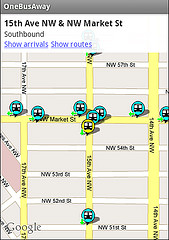
Finally, I thought! I’d never again have to wait around for a bus that’s 20 minutes late. I’d know exactly when the next bus would arrive, shrinking my wait time at the stop.
And it’s true: in my daily commute, OneBusAway tells me when buses are coming and if any are delayed significantly. But has it significantly changed how I ride?
Well, not really.
To be honest, I still get out the door at the same time most mornings. And I leave work when the work is done. I might check my phone before stepping out the door to see where things are at, but it very rarely changes my routine.
For me, it’s not a game-changer, but the reason is not the app; it’s the transit-friendly locations of my apartment and office. I’m lucky; I live in a neighborhood with a good bus system. My front door is within five minutes of three bus routes that take me straight to the office; all of them come pretty frequently at peak commute hours.
I’m never tempted to drive, since the bus ride takes about the same amount of time and let’s me catch up on reading. Plus, compared to the hundreds a month I’d spend on gas and parking, the bus is a steal. It’s the perqs of living in a walkable neighborhood close to the urban core and crisscrossed with transit lines that make my commute a breeze.
But for others, transit technology can make a big difference. Commuters who live a little further out from the city center (or in the ‘burbs) likely rely on a handful of express buses—time-savers that can cut commute times in half or more. For them, knowing exactly when that bus or train is going to arrive could save hours each week.
For those folks, access to accurate transit information can be the deciding factor between pulling out of the driveway alone in their car or taking a brisk morning walk to the bus stop. It’s a trend that transit agencies—and technology enthusiasts (nice word for geeks)—are catching on to.
Already, northwest transit providers have email and text-message alerts for route changes and closures, construction, and storm- or emergency-related changes; some buses are equipped with GPS tracking to provide exact location information; and light rail (and planned BRT) stations display when the next train is arriving.
New services and applications are cropping up left and right to help people figure out their transportation options while they’re on the go. Following in the steps of Walk Score, sites like TravelSmart and City-Go-Round offer an array of tools for transit riders looking to get connected. Plus, transit reps are hopping on to social media sites like Twitter to provide updates and answer questions.
With gas prices creeping up, many car commuters will again be thinking over their options. Convenient (and cool) planning tools and real-time information could tip the scales toward transit for many.
So that’s my smart phone story. It wasn’t really the revolutionary transformation I expected (other than the fact that my morning reading has been replaced by 20 minutes playing Angry Birds). But I do feel more empowered just by having the information; it adds confidence to the days my routine changes and I need transit info on-the-fly. And on that side of things, I suspect I’m not alone.
OneBusAway screenshot from www.onebusaway.org.

Comments are closed.